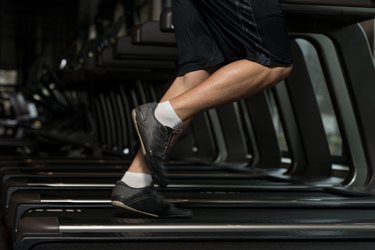
Ask any bodybuilder and they will tell you that calves are one of the few body parts that do not respond well to exercise, regardless of how hard you train them. Some people are blessed with great aesthetic calf muscles, and some are stuck with calves they'd rather not put on display. While you can improve the definition of your calf muscles by working them with specific calf exercises, as far as changing the shape of the calf -- especially lengthening it -- it's basically impossible.
The Anatomy of the Calf
Video of the Day
The superficial muscles of the calf that you would be concerned with are the gastrocnemius nicknamed the gastroc (the ball of the calf muscle), the soleus (the muscles that taper down the sides into the ankle), and possibly the fibularis longus (the lateral muscle of the calf). Likely, you would want to raise gastroc heads and tighten the soleus, which would create a slim, long ankle with the majority of the muscle up closer to the knee.
Video of the Day
The Problem
The length of the gastroc is dependent on the length of your Achilles tendon. And if you were able to pull the gastroc up, you would therefore have to tear your Achilles and never walk correctly, ever again. The Achilles is assembled with basically zero slack, so that when you need to sprint or jump in an emergency situation, your foot is maximally responsive. The point is, there is no exercise that will actually change the length of your calf muscles the way you can lengthen dough with your hands.
Trigger point, myofascial release, and even yoga practice are effective in getting the sliding filaments of your muscles to relax the microscopic sarcomeres and create a loose, more limber muscle. These practices are beneficial for muscle performance and internal muscle arrangement, but don't actually change the external appearance of the muscle, the same way stretching your legs won't make you taller.
Think Like a Magician
A magician is actually an expert at misdirection, having the audience looking at one thing so they miss the important, revealing pieces. Create magic with your calves by making them appear longer and slimmer just by bringing out their true character. First, start sprinting and jumping, on grass, on sand, up hills, up bleachers. The more top-speed high impact movements you do, the tighter your calf muscles will become to adapt to the intensity of the work they do. This will display a sleek, dynamic calf rather than a fleshy area where you trust that humans typically have muscle.
The Magician's Final Act
Now that you're sprinting and jumping, it's time to close the act with the highlight of the show: nutrition. If you have thick, meaty calves with which you are unhappy, you might have some unwelcome extra-ness in other areas of your body. Cut out all sugar, especially fructose, eat plenty of animal protein and healthy fats, and eliminate all inflammatory carbohydrate intake -- anything wheat, soy, corn based. Staying hydrated and keeping your insulin levels low will get you promoted to captain of the fat-burning brigade and help sculpt the calves of your dreams.
- Asp ML, Richardson JR, Collene AL, Droll KR, Belury MA.: Dietary Protein and Beef Consumption Predict for Markers of Muscle Mass and Nutrition Status in Older Adults. J Nutr Health Aging. 2012;16(9):784-90. doi: 10.1007/s12603-012-0064-6.
- McKeown NM, Meigs JB, Liu S, Rogers G, Yoshida M, Saltzman E, Jacques PF.: Dietary Carbohydrates and Cardiovascular Disease Risk Factors in the Framingham Offspring Cohort. J Am Coll Nutr. 2009 Apr;28(2):150-8.
- Song SJ, Lee JE, Paik HY, Park MS, Song YJ.: Dietary Patterns Based on Carbohydrate Nutrition are Associated With the Risk for Diabetes and Dyslipidemia. Nutr Res Pract. 2012 Aug;6(4):349-56. doi: 10.4162/nrp.2012.6.4.349. Epub 2012 Aug 31.
- Anatomy of Calf Muscles (Image)